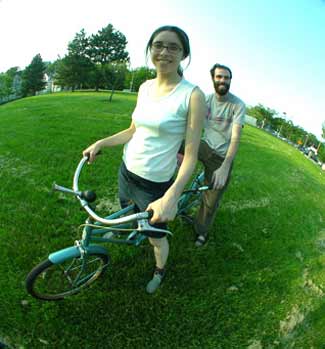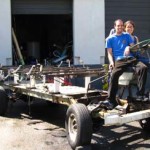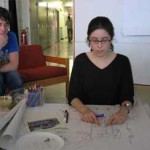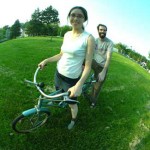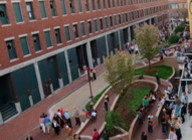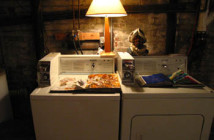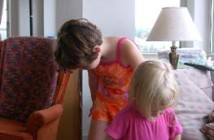Flip through an issue of Metropolis magazine and you’ll encounter stories about office chairs that save our spines, restaurants that save dining, and bus shelters that save bus waiting. Its pages of glossy photos ring affirmatively: Design will Save the World.
The Busycle project is not quite as sexy as Philip Starck’s new chair, but it will certainly save bus-biking everywhere. The project began in May by long-time friends and fellow sculptors Heather Clark and Matthew Mazzotta when they were awarded theBerwick’s Artist in Research Residency. Early in the building, they were forced to work at another location (“The Berwick didn’t have garage doors.”) and found a home in Sparqs Industrial Arts Club in Woburn, MA.
From the beginning the project was a group effort. The two artists sought help from everywhere they could think of: Car Talk,Craigslist, local bike shops, Bikes Not Bombs, Critical Mass, and bike experts/professors at MIT. The pair found a core group of workers who quickly turned into a family. It’s an unusual mix of people: a pastry chef, a professional French horn player, the man who started the first American team at Junkyard Wars in the UK, a videographer, a military lab worker who puts lasers on airplanes, a math teacher, a midwife, bike legend Cave Dave (called thus because he used to live in a cemetery), a physics teacher, an architect, and an engineer with farming expertise. They range in age and position but have all found something fulfilling in the Busycle project.
The first stage of design was, as tends to be the case, dominated by debate and hours spent drawing and re-drawing and arguing about what way they could best accomplish their goals through design. Many hours were also spent learning how to weld and about how trucks work. Clark is more than happy, for example, to explain the entire drive system of a car to anyone who would like to know (Engine to driveshaft, driveshaft to differential, gears, gears, gears = wheels spinning in right direction is about what I picked up). Their new expertise manifests itself in the Busycle’s good design: it’s as slick as a 14-person van full of pumping leg power could be. It’s still just the skeleton of a vehicle – or “naked”, as Clark says – and the team will continue to develop the visual aspect of the Busycle throughout the fall.
Their priority, however, is to get the thing working. It will be appearing in the Hub on Wheels event September 25th and will receive a police escort across town to participate in Boston’s 375th anniversary parade. “And we don’t want it to just be a float,” says Mazzotta.
The Busycle team is larger even than the group of people building it. Because of the project’s tiny budget, the Busycle relies heavily on donations. Local bike shops have contributed huge numbers of bike parts, office chairs came from Harvard, and one man from Craigslist donated a van. The Berwick offers its support in critique form and the various aspects of promotion, Bikes Not Bombs provided consultation as well as tons of parts, and Sparqs “basically made it all possible,” says Clark. “They provided us with a space to work as well as the training we needed to build.”
Reliance on donations has slowed progress, but ideologically, it couldn’t be any other way: the team is committed to using 100% recycled materials. “Seeing something old or trashed that’s been reused in a creative way…It’s such a beautiful thing,” says Mazzotta. Those who agree with him will be thrilled to see the flatbed of a van, chopped off sections of exercise equipment, and two bed frames reconfigured to suit the needs of the Busycle. “It’s as if the whole project was all here already,” he says, “All the elements were there and it just came together. It’s a culmination.”
Ultimately the pair hopes to take the Busycle to different neighborhoods around Boston and see what happens. What kind of conversations are going to take place on this thing? Who will ride it? How will it work in different areas of the city? How will it operate in relation to rapidly rising gas prices? What does it say about sustainable transportation? Though Clark and Mazzotta are fascinated by the engineering aspects of the project, it’s the social aspects that brought them to it in the first place. They are both advocates of “off the grid” living and green building. Clark works in housing development and Mazzotta is a carpenter by trade. They grew up in rural Canton, NY where there is a huge green building movement and hope to adapt that attitude to an urban environment.
“The Mayor’s office (which has supported this project) advocates green buildings, but it hasn’t really been done in Boston,” says Clark. “It’s unusual because green building is generally correlated with education and wealth,” which Boston certainly has in spades. Clark and Mazzotta will be working together in the future to build some self-sufficiency into the visual environment. They hope to make a city that is more walkable and bikeable, with buildings that fit in with the environment and utilize passive solar and bio-filtration – in other words, save the world.
Sparqs owner Tim Panagos’ project is less about saving the world, more about saving ourselves. “The real reward of these projects is the state of being that [building]encourages in the people who do it. Something about craftsmanship plugs you into a spiritual place – there’s an element of selflessness.”
“Besides,” he says, “if cable is a necessity, this should be.” And for that reason Sparqs’ lowest membership rate is equal to one month of Tim Panagos’ cable bill.
- Mazzotta and Clark with a the Busycle.
- Heather Clark looks over plans for the driveshaft design.
- Busycle artists Matthew Mazzotta and Heather Clark.
Links:
The Busycle project
The Berwick Research Institute
Sparqs Industrial Arts Club
On September 25th, the Busycle will be riding in the city of Boston's Hub on Wheels event that morning and later that day will be riding in the City of Boston's 375th Anniversary parade.
All images are courtesy of the artist and The Berwick.

